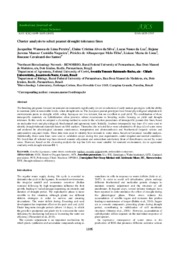Cluster analysis to select peanut drought tolerance lines.
Cluster analysis to select peanut drought tolerance lines.
Author(s): PEREIRA, J. W. DE L.; SILVA, E. C. A. DA; NOGUEIRA, R. J. M. C.; MELO FILHO, P. DE A.; LIMA, L. M. de; SANTOS, R. C. dos
Summary: The breeding programs focused on semiarid environments significantly invest on selection of early-mature genotypes with the ability to maintain yield at reasonable levels, when drought sets in. The fastigiata peanut genotypes have broad physiological adaptation to environments prone to drought, while subsp. hypogaea are less tolerant, but are excellent to pod yield. The combination of these intraspecific materials via hybridization often provides robust descendants to breeding works focusing on yield and drought tolerance. In this work we adopted a clustering method to assist in the selection procedures of intraspecific peanut elite lines, based on molecular tools and physiological, biochemical and agronomic traits. Initially, fourteen intraspecific top lines (F7) were used to identify drought tolerant materials based on SSR markers. Thereafter, the selected lines were submitted to 10 days (d) of water stress and analyzed by physiological (stomata conductance, transpiration and photosynthesis) and biochemical (organic solutes and antioxidative enzymes) traits. These data were used to identify lines tolerant to water stress, based on Canonical variable analysis. Additionally, these same lines were used in validation assays during two year experiments, under irrigated and rainfed conditions. We found that all selected top lines showed osmotic adjustment and antioxidant satisfactory front of disturbances caused by water stress. However, based on the clustering analysis the top line L46 was more suitable for semiarid environment, due to agronomic similarity with drought tolerant-BR 1.
Publication year: 2015
Types of publication: Journal article
Unit: Embrapa Cotton
Observation
Some of Embrapa's publications are published as ePub files. To read them, use or download one of the following free software options to your computer or mobile device. Android: Google Play Books; IOS: iBooks; Windows and Linux: Calibre.
Access other publications
Access the Agricultural Research Database (BDPA) to consult Embrapa's full library collection and records.
Visit Embrapa Bookstore to purchase books and other publications sold by Embrapa.

